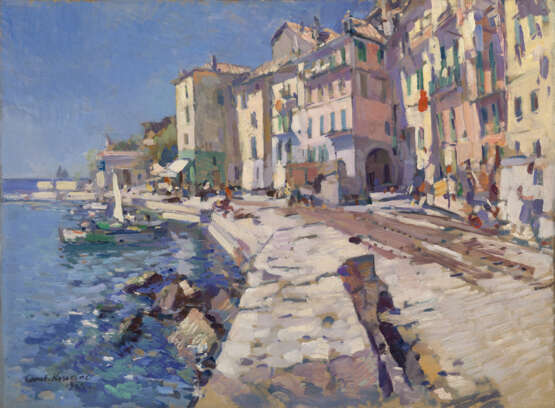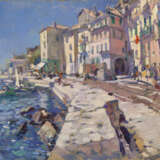ID 1383
Los 18 * | KOROVIN, KONSTANTIN (1861-1939)
Schätzwert
£ 300 000
Quai de l’Amiral Courbet, Villefranche-sur-Mer, signed and dated 1922, further inscribed “Pour Henri Mougenot” on the stretcher.
Oil on canvas, 59.5 by 80.5 cm.
300,000-400,000 GBP
Provenance: Russian Pictures, Sotheby’s London, 20 November 2002, lot 90.
Acquired at the above sale by the present owner.
Important private collection, Europe.
Authenticity of the work has been confirmed by the expert V. Petrov.
Quai de l’Amiral Courbet, Villefranche-sur-Mer features among Konstantin Korovin’s early and best works from the French period of his life.
In 1922, the artist left Soviet Russia with an exhibition of his works and went to Germany and later to France, where he settled with his family in Paris. However, his son soon developed pleurisy and became seriously ill, and Korovin had to relocate his family southwards to the seaside. The artist writes in his memoirs: “My son’s illness forced me to head south. I spent nearly a year on the coast, in Villefranche.”
Finding himself now in the south of France after the miserable and harsh post-revolutionary years that he had spent far from city life in the Tver region, with its northern, changeable climate, the artist truly revelled and gloried in the bright southern sun. He paints from life once again, going out for walks along the coast day after day with his easel.
Korovin’s choice of Villefranche was not random. This little town, which lies on the eastern fringe of the French Riviera, on the coast of one of the most picturesque bays of the Côte d’Azur, six kilometres east of Nice, was considered in the late 19th and early 20th century to be a “Russian” resort. In the second half of the 19th century, a Russian naval base was located here, and the harbour of Villefranche-sur-Mer was built at the order of the Emperor Alexander II. The expansion of ties with Russia was further facilitated by the Russian Empress Alexandra Fyodorovna’s visit to Villafranca, as the town was then known (its Italian name), a visit that was then followed by an influx of aristocratic dignitaries and nobles from Russia who came to spend their winter holidays there. By the 1920s, there was still a Russian oceanological research observatory operating in Villefranche, and Russian émigré holidaymakers traditionally preferred this small town to Nice.
Today, at least two works that Korovin painted in Villefranche are known. They are dated 1922 and 1923 and both were executed from virtually the same viewpoint – evidently, the most scenic one. Yet the composition presented for auction seems even more interesting and striking. The horizontal format that Korovin chose for it enabled him to show the curve of the coastline and to include a sizeable part of the seascape in the panorama of the small seaside town stretching along the coast. Both views of Villefranche illustrate Korovin’s romantic passion for depicting sails and boats at a quayside. The artist proves able to express in these landscapes the genius loci – the soul of a town whose whole life centres on the Quai Courbet.
In this vivid work, one can feel the sensuously palpable nature of Korovin’s best southern landscapes. The freshness with which real life is perceived, the freedom of self-expression, and the subtlety with which the effects of light are conveyed, as well as the beauty and rich colour of the southern, Mediterranean way of life, generate a feeling of joy, and the thirst for living that is typical of many of Korovin’s landscapes.
The quayside, deserted during the siesta, the seemingly sun-bleached buildings and the vibrant greenish-blue shadows in the water are depicted with the brilliant artistry and bravura of Korovin’s painting in the 1910s.
Interestingly enough, this is the view that was favoured in the early 20th century by photographers who took pictures of the well-known resort for countless postcards and advertising publications. It may have been his familiarity with this sort of output that inspired the artist to create the eye-catching and skilful pictures that he intended for sale.
* Indicates Import Duty Charge applies.
| Adresse der Versteigerung |
MacDougall Arts Ltd. 33 St James’s Square SW1Y 4JS London Vereinigtes Königreich | ||||||||||||||
|---|---|---|---|---|---|---|---|---|---|---|---|---|---|---|---|
| Vorschau |
| ||||||||||||||
| Telefon | +44 20 7389 8160 | ||||||||||||||
| Telefon | +7 495 799 4683 | ||||||||||||||
| Fax | +44 (0) 20 7389 8170 | ||||||||||||||
| Aufgeld | 27 % | ||||||||||||||
| Nutzungsbedingungen | Nutzungsbedingungen | ||||||||||||||
| Geschäftszeiten | Geschäftszeiten
|




